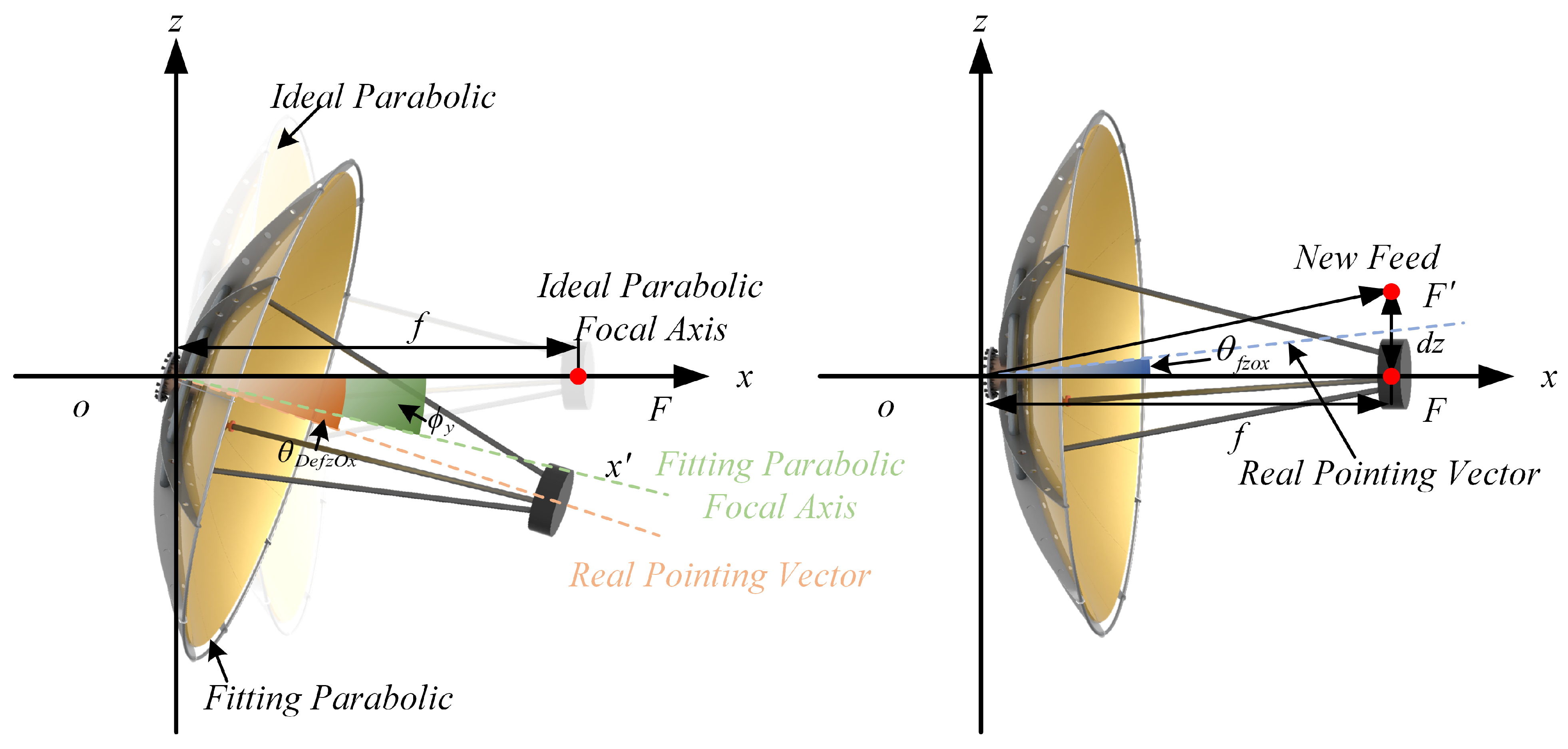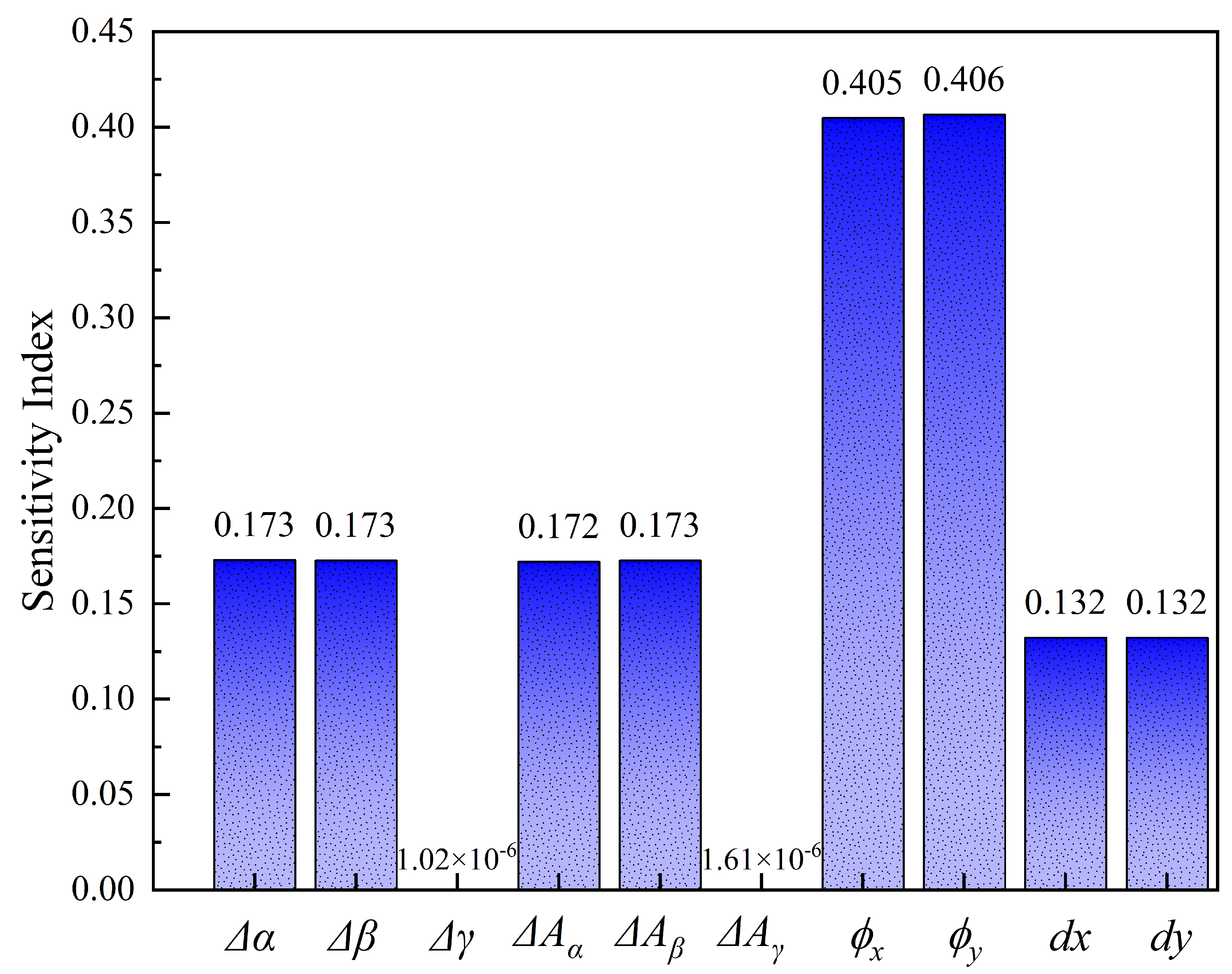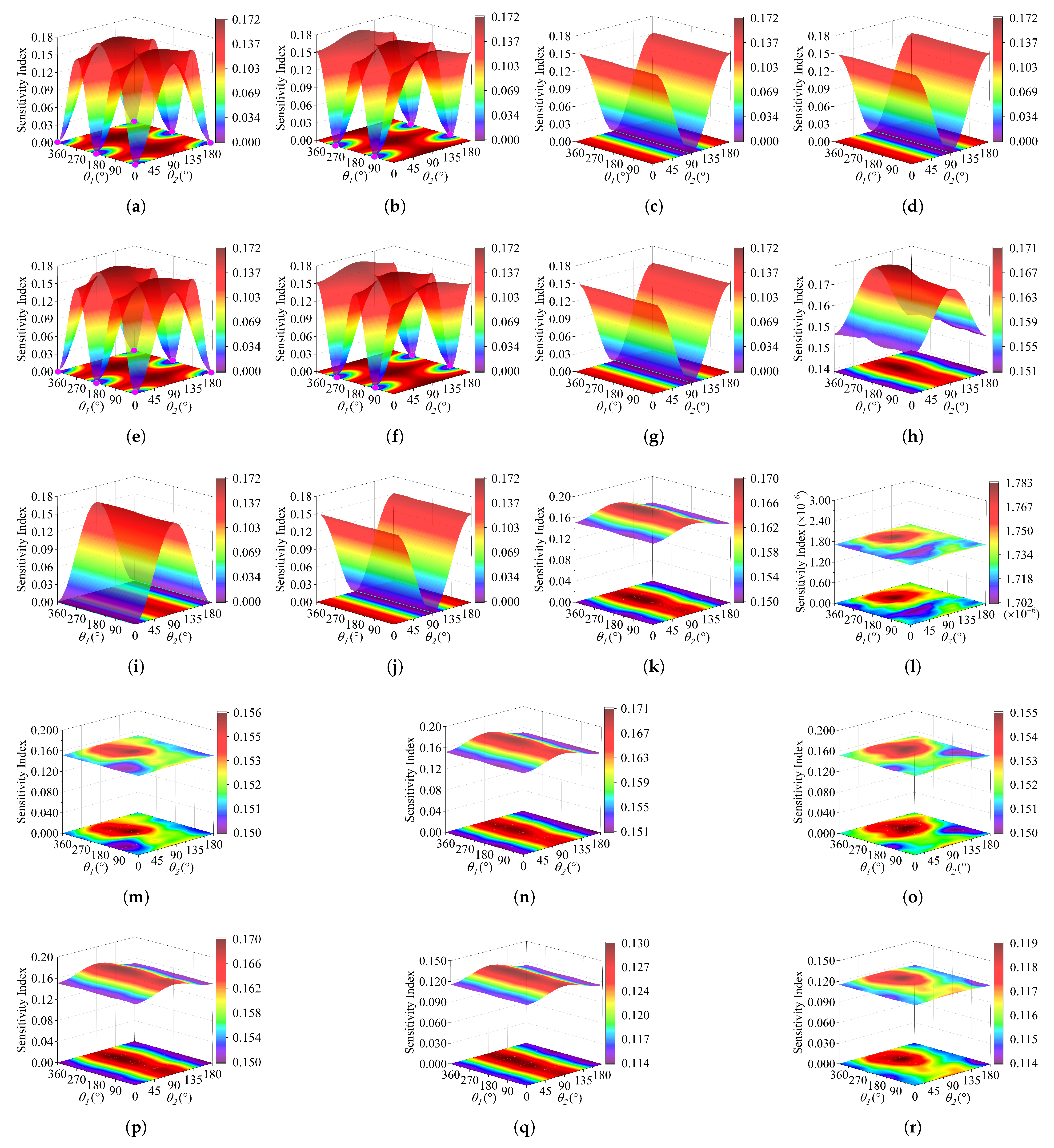Then, by using the method proposed in the previous section, a numerical model is established by the sorted out parameters. This model combines the uncertain parameters and the antenna pointing performance to analyze the distribution characteristics of antenna pointing performance in the imaging space.
The accuracy of the proposed framework is validated by comparing the statistical moments with those obtained by the MCS method. Furthermore, based on the computed statistical moments, the reliability of the antenna pointing performance within the imaging space is analyzed and compared with the results of MCS to confirm the precision of the reliability calculations.
4.2.1. Kinematic Model and Sensitivity Analysis
The satellite model with a dual-axis driving mechanism and its coordinated systems is shown in
Figure 10. It contains a mainbody and an antenna, and a dual-axis driving mechanism between these two parts. The kinematic parameters of the satellite are provided in
Table 8. The position vector and rotation angle in the
ith row are relative to the coordinate system in the
row.
To analyze the sensitivity index in the imaging area, the rotation angle of two shafts denoted as
and
are considered in the real and ideal pointing vector. By using Equation (
7) and Equation (
15), the transformation matrices that contain
and
are obtained. The two pointing vectors in Equation (
16) and Equation (
17) become
and
. The antenna pointing performance considering the uncertain parameters can be derived by Equation (
18).
Table 9 gives the probability distribution of uncertain parameters. The sensitivity index of each uncertain parameter can be quantified by decomposing the antenna pointing performance expression through Equation (
23). The total partial variance of each parameter is given by Equation (
28), and the total variance is expressed by Equation (
26). The total sensitivity index of each uncertain parameter in the imaging area is calculated by Equation (
29). The results are shown in
Figure 11.
As shown in
Figure 11, the sensitivity indices of the antenna pointing performance are illustrated for various uncertain parameters within the imaging area. These parameters can be categorized by the comparison between the trend of these figures in the imaging area, as shown in
Table 10.
These uncertain parameters are categorized into several types by their trends in the imaging area, shown in the Table above. Detailed descriptions of these types are given as follows:
Type 1: This type includes uncertain parameters whose sensitivity indices feature multiple zero points within the imaging area. These zero points in the figures are marked in magenta. This type further divided into two subtypes:
- –
Subtype 1.1: This subtype contains . There are six zero points in the sensitivity figures. The surface of the sensitivity index exhibits symmetry at and . Along the axis, the surface exhibits periodic variations with a period of .
- –
Subtype 1.2: This subtype contains . There are four zero points in these figures. Same as the Type 1.1, it shows symmetry in the and . It also has periodicity along the axis and shows a phase difference of in the axis compared with the Type 1.1.
Type 2: In this type, the sensitivity surfaces of uncertain parameters have a line equal to zero. These zero lines are marked in green. The surfaces change along the axis are more significant than the axis. It is divided into two subtypes:
- –
Subtype 2.1: are contained in this subtype. The sensitivity parameters in this type are shown as a V shape along the , while the two remains steady. The minimum value is located at , and the maximum value is obtained at and .
- –
Subtype 2.2: is in this subtype. The sensitivity index in this type is shown like an A shape along the , while remains steady. The minimum value is located in and while the maximum value is obtained in .
Type 3: This type contains , , , , , , . Parameters of this type continuously influence the antenna pointing performance. Their sensitivity indices have non-zero minimum points within the imaging area. These indices can only be changed by altering the antenna pointing angles and .
Type 4: Only is included in this type, which has no influence on the antenna pointing performance in the imaging area.
As shown in
Figure 11, the sensitivity analysis demonstrates that antenna pointing performance is more sensitive to uncertain parameters near the antenna than to those farther away, a finding which exactly matches Case I. The uncertain parameters near the payload always influence the antenna pointing performance, while parameters far away from the antenna have several zero points or lines. Furthermore, the uncertain parameters that rotate around the focal axis do not influence the antenna pointing performance, like
. The sensitivity results of uncertain parameters in Types 1, 2, and 3 show a higher level of sensitivity than the parameters in Type 4. Type 3 always has an influence on the antenna pointing performance. The sensitivity changes range in the imaging area of Types 1 and 2 are larger than Type 3.
4.2.2. Reliability Analysis
This section analyzes the reliability of antenna pointing performance considering uncertain parameters. As identified in the previous subsection, these parameters were prioritized based on sensitivity indices. The selected key parameters for the reliability analysis of antenna pointing performance are:
,
,
,
,
,
,
,
, and
. Their distribution parameters are detailed in
Table 9. Statistical moments of pointing performance computed via GSA-PEM for each pointing direction are validated against the MCS method. The MCS required
computations, whereas the proposed framework achieved comparable results with only 140 computations.
By substituting the mean value of each parameter into Equation (
38), the constant
in Equation (
37) is obtained. The sample points
of variable
are calculated by Equation (
47), and the values of
and
are shown in
Table 2. The mean and SD values of
ith parameter are derived by Equations (
44) and (
45). The mean and SD values of the antenna pointing performance are then calculated by Equations (
34) and (
35), and the reliability analysis can be carried on.
The reliability of the antenna pointing performance is verified by comparing the first- and second-order moments of pointing performance using the GSA-PEM and the MCS method. The mean and SD in the imaging area of these two methods are shown in
Figure 12.
The figures above compare the statistical moments between the GSA-PEM and the MCS method. As shown in
Figure 12a,c, the magenta surface represents the result of the GSA-PEM, while the blue surface is the MCS result. The trends of the two methods in both figures within the imaging area are consistent. The GSA-PEM yields slightly higher values at the upper and lower bounds of
in the imaging area. The mean and SD of the GSA-PEM are the same as those of the MCS method while
.
Figure 12b,d show the difference in moments between the two methods. Both figures show that the error of moments changes along the
axis while remaining steady along the
axis. The yellow area surrounded by the orange line in the two figures means the error is less than
. The minimum error of the mean is located near the
, while the maximum error is located near the
and
. For the SD, the minimum error is located near the
to
. The maximum error of the SD is the same as the mean, located near the
and
.
For the calculation cost of these two methods, in the single pointing direction, the GSA-PEM calls the antenna pointing performance function 196 times. In contrast, the MCS method needs times, which shows that the GSA-PEM is more efficient than the MCS method.
As shown in Case I and reference [
12], the antenna pointing performance follows the Rayleigh distribution (Weibull distribution with shape parameter equal to 2). The PDF and CDF curves of the antenna pointing performance in certain
and
are given below.
The comparison between the two methods is shown in
Figure 13. Each sub-figure has 4 curves, the solid line is the result of the MCS method, and the dotted-and-dashed line is the result of the GSA-PEM. The two colors blue and red are used to represent the PDF and CDF curves, respectively. These figures demonstrate that the PDF and CDF obtained by the GSA-PEM are the same as the result of the MCS method. This indicates that the proposed framework can effectively quantify the probabilistic characteristics of antenna pointing performance under uncertainty.
The antenna pointing performance reliability with different error thresholds is analyzed. The thresholds of the antenna pointing performance are 0.2°, 0.6°, and 1°. The reliability results of the two methods given by the PDF and CDF are shown in
Figure 14.
The reliability results of the antenna pointing performance with different thresholds are shown in
Figure 14. Reliability results with different thresholds are shown in
Figure 14a–c, respectively. It can be found that the reliability results of both methods have the same trend in the imaging area. The reliability along the
axis remains unchanged while it changes along the
axis like an A shape.
The reliability along the
axis remains unchanged, while it changes along the
axis.To analyze the reliability of the antenna pointing performance, the surfaces are projected on the
plane (
z is the reliability axis), as shown in
Figure 14d–f. The reliability results of both GSA-PEM and the MCS method can be found to have the safest location near
for each threshold, and the most unsafe locations are located in
and
.
The reliability errors between the two methods are shown in
Figure 14g–i. The errors of these two methods can be found to be shown as an A shape along the
axis. The most accurate position is located between
and
with reliability error near
. The maximum error occurs in
and
, and decreases from
,
, and
as the threshold increases.
The reliability results indicate that the GSA-PEM can provide a proper estimation of the antenna pointing performance for different types of satellites with multiple uncertain parameters. The GSA-PEM enables quantification of antenna pointing performance variations within the imaging area, providing an effective approach to evaluate the antenna pointing performance.




















